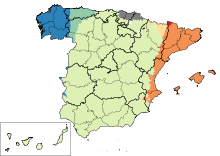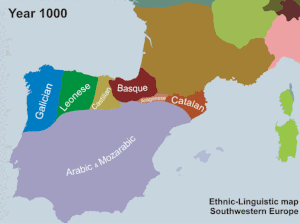The majority of languages of Spain[4] belong to the Romance language family, of which Spanish is the sole one with official status as the national language.[5][6] Others, including Catalan/Valencian (in Catalonia, Valencia and the Balearic Islands) and Galician (in Galicia), enjoy official status in their respective autonomous regions, similar to Basque in the northeast of the country (a non-Romance language isolate). A number of other languages and dialects belonging to the Romance continuum exist in Spain, such as Aragonese, Asturian, Fala and Occitan (sometimes called Provençal).
| Languages of Spain | |
|---|---|
| Official | Spanish (country-wide); Catalan/Valencian, Galician, Basque and Occitan (selected territories) |
| Regional | Amazigh, Ceutan Arabic, Aragonese, Aranese, Asturleonese, Basque, Catalan, Galician.[1] |
| Minority | Caló[1] |
| Immigrant | Portuguese, Romanian, Quechua, English, German, French, Bulgarian, Ukrainian, Russian, Wolof, Punjabi,[2] Hindu–Urdu, Wu dialects (Qingtian & Wenzhounese)[3] (see immigration to Spain) |
| Signed | Spanish Sign Language Catalan Sign Language Valencian Sign Language |
| Keyboard layout | |
Present-day languages

The languages spoken in Spain include:
- Spanish. Official throughout the country, it is spoken by the majority of the population.
- Catalan, co-official in Catalonia, the Valencian Community and the Balearic Islands. Catalan is also spoken in the eastern strip of the Aragon region (La Franja) and in the Carche area of the Region of Murcia. It is known as Valencian in the Valencian Community[7][8] and el Carche.
- Galician is spoken in Galicia (where it has co-official status) as well as in nearby areas of Asturias and Castile and León.
- Basque, co-official in the Basque Country and northern Navarre (see Basque-speaking zone). Basque is the only non-Romance language (as well as non-Indo-European) with an official status in Spain.
- Aranese is a standarized variety of Occitan which is co-official in Catalonia.[9] It is spoken in comarca of the Aran Valley, near the French border.
- Asturian, a standarized variety of the Asturleonese dialect continuum. It enjoys protection in Asturias, where reportedly about 25% of the population is able to understand, speak, read, and write in the language.[10] Asturleonese varieties collectively known as Leonese are spoken in parts of Castile and León (provinces of León and Zamora), where they enjoy legal protection.
- Aragonese, spoken in the north of the Aragon region, in the Pyrenees. It enjoys legal protection.
- Fala: This romance language belonging to the Galician-Portuguese group is spoken by about 6,000 people in the Jálama Valley. It has been declared Bien de interés cultural.[11]
- Silbo Gomero is a whistled code in La Gomera (Canary Islands). Protected by UNESCO[12] (Intangible Cultural Heritage of Humanity).
- Portuguese has been traditionally spoken by the inhabitants of the following border areas: Cedillo and Herrera de Alcántara (province of Cáceres),[13] La Alamedilla (province of Salamanca, primarily spoken in the place up until the mid-20th century),[14] and Olivenza (province of Badajoz).
- Darija Arabic is spoken in Ceuta. It lacks government protection.[15]
- Riffian is spoken in Melilla. It lacks government protection.[16]
- Caló, a mixed language, is spoken by the Spanish Romani communities across the country, with a large concentration in Andalusia and Catalonia, though it seems to be in the process of becoming just a dialect of Spanish. It should not be confused with Romani, the Indo-Aryan language originally spoken by gypsies, which is most probably no longer spoken in Spain.
Other Romance varieties
Spanish itself boasts a substantial internal variation in the country. For example, the Andalusian or Canarian dialects, each with their own subvarieties, some of them being partially closer to the Spanish of the Americas, which they heavily influenced to varying degrees, depending on the region or period and according to different and non-homogeneous migrating or colonisation processes. Despite being a dialect, some Andalusian speakers have attempted to promote Andalusian as a different language independent of Spanish.
Five very localised dialects are of difficult filiation: Fala (a variety mostly ascribed to the Galician-Portuguese group locally spoken in an area of the province of Cáceres sometimes called Valley of Jálama/Xálima, which includes the towns of San Martín de Trevejo, Eljas and Valverde del Fresno); Cantabrian and Extremaduran, two Astur-Leonese dialects also regarded as Spanish dialects; Eonavian, a dialect between Asturian and Galician, closer to the latter according to several linguists; and Benasquese, a Ribagorçan dialect that was formerly classified as Catalan, later as Aragonese, and which is now often regarded as a transitional language of its own. Asturian and Leonese are closely related to the local Mirandese which is spoken on an adjacent territory but over the border into Portugal. Mirandese is recognised and has some local official status.
Statistics
Top language spoken at home (Pew Research survey, 2019)[17]
In terms of the number of speakers and dominance, the most prominent of the languages of Spain is Spanish, spoken by about 99% of Spaniards as a first or second language.[18] According to a 2019 Pew Research survey, the most commonly spoken languages at home other than Spanish were Catalan in 8% of households, Valencian in 4%, Galician in 3% and Basque in 1%.[17]A study in 2016 by the University of Navarra focused on which languages were used most frequently to consume news within a week (using multiple-choice surveys). The response included foreign languages, Spanish and only co-official and protected languages. 95.2% of news was consumed in Spanish and 30.4% in a co-official or protected language.[19]
| Language | Language of news consumption in the last week (%)[19] |
|---|---|
| Spanish | 95.2 |
| English | 23.9 |
| Catalan/Valencian | 21.6 |
| French | 7.2 |
| Galician | 5.5 |
| Basque | 2.6 |
| Portuguese | 2.0 |
| German | 1.9 |
| Asturian/Leonese | 0.9 |
| Romanian | 0.7 |
| Aragonese | 0.6 |
| Arabic | 0.3 |
| Aranese | 0.3 |
| Other foreign language | 2.0 |
| Other regional language | 1.0 |
The study reflects that the consumption of protected languages is proportional to their knowledge and that the consumption of foreign-language news is greater than that of regional-language news.
Language policy
Spanish is official throughout the country; Catalan/Valencian, Galician, Basque, and Occitan have legal and co-official status in their respective communities and (except Occitan) are widespread enough to have daily newspapers and significant book publishing and media presence. Catalan and Galician are the main languages used by the respective regional governments and local administrations. Starting in 2023, members of the lower house of the Spanish Parliament were allowed to use Basque, Catalan and Galician in their interventions.[20] Members of the upper house already could use those languages in some specific discussions and initiatives.[21]
In addition to these, there are some protected languages. A protected language does not have co-official status but can be taught in schools as an optional subject, with the possibility of having TV shows in the protected language as well as institutions for that language.
Limited Asturian-language broadcasting is available on RTPA, and the language is learned as an optional subject by 53% of primary education students.[22] There is a prominent movement demanding for the declaration of Asturian as an official language in Asturias, which is a matter of an ongoing political debate.[23][24]
As of 2023, Aragonese is offered as a subject in about 30 schools in the Aragon region, with around 1,300 students.[25] Limited Aragonese-language television content is available on the regional public broadcaster, with shows such as A Escampar la Boira[26] or Charrín Charrán.[27]
Past languages
Alongside the languages spoken in Spain to the present day, other languages were spoken within the actual borders:

- Tartessian language
- Iberian language
- Celtic languages
- Lusitanian language
- Punic language
- Latin language
- Guanche language
- Galician-Portuguese
- Gothic language
- Vandalic language
- Frankish language
- Arabic
- Mozarabic languages
- Romani language
Languages mostly spoken outside Spain but which had roots in Spain:
- Judeo-Catalan, (the existence of this language has been questioned)[citation needed].
- Judaeo-Spanish (Ladino)[28]
Variants
There are also variants of these languages proper to Spain, either dialect, cants or pidgins:
See also
References
External links
- Detailed Ethno-Linguistic map of Pre-Roman Iberia (around 200 BC)
- Detailed linguistic map of Spain
- Languages in Spain - Find out information about the Official languages of Spain.


